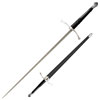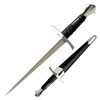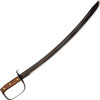|
|
|
 |
|
| Cold Steel Ribbed Shell Swept Hilt Rapier (88CHR) |
Points: 30
|
Sadly, while never proven ineffective or obsolete, the rapier eventually succumbed to the dictates of fashion and gave way to the emerging small sword. Happily Cold Steel has chosen to revive the Rapier with our own interpretation designed by Dave Baker. The long, narrow blade is fully sharpened and beautifully polished with a single wide fuller at the forte to assure perfect balance. The hilt also reflects the best in craftsmanship and materials fashioned from stainless steel featuring a classic ribbed shell and multiple bars, quillions and knuckle bow for unparalleled hard protection. The grip itself is made of wood covered with rich black ray skin and decorative wire and terminates in a heavy ribbed pommel that serves as a counter balance to our Rapier's long blade.
|
|
|
|
|
|
 |
|
| Cold Steel Sword Italian Long Sword (88ITS) |
Points: 29
|
The era of the long sword spanned almost three centuries (approximately 1350 to 1650). This, undoubtedly, was because it really worked! It featured a distinctive cruciform hilt and a long, double edged blade and was equally adept at opposing both light and heavily armored foes. You see, its extra long blade offered the reach and leverage for powerful stabbing, cutting and chopping strokes while its long cross guard and heavy pommel were useful for hooking, striking and smashing.
|
|
|
|
|
|
 |
|
| Cold Steel Dagger Italian Dagger (88ITD) |
Points: 14
|
Since our Italian Long Sword is light and well balanced enough to use in one hand we thought we'd offer a companion dagger to take the place of a shield, targe, or buckler. Scaled down in size but almost identical in appearance, its sharply tapered, double edged blade slightly favors attacks with the point over the edge and is stiff and strong enough to parry any sword.
|
|
|
|
|
|
 |
|
| Cold Steel Talwar Saber (88EITB) |
Points: 18
|
Here at Cold Steel, we have been fascinated with the Talwar for decades, and we have made it our mission to bring the highest quality production version of this historically significant sword to the market.
|
|
|
|
|
|
 |
|
| Cold Steel Battle Gim (88FG) |
Points: 25
|
The Battle Gim is forged from our best DAMASCUS STEEL by talented smiths, it features a broad symmetrical point and a slightly wider, heavier blade than custom would dictate. This gives it a more pronounced blade-heavy balance making its twin razor-sharp edges slightly more suitable for cutting and slashing than thrusting.
The attractive Rosewood hilt is framed by a blackened iron guard and pommel. They're embellished with an intricate filigree of traditional Chinese Peony flowers and leaves. The matching Rosewood scabbard is styled in a similar fashion on its chape, throat and ring mounts.
|
|
|
|
|
|
 |
|
| Condor Naval Cutlass (CTK360-24HC) |
Points: 5
|
Condor Naval Cutlass features 24" curved blade made of 1075 high carbon steel a half basket guard.
Brown hardwood handles with black powder coated steel hand guard. Black leather belt sheath included.
|
|
|
|
|
|
 |
|
| Hanwei Tinker Pearce Norman Sword - Blunt (SH2427) |
Points: 10


|
The Tinker Norman sword pair, with their distinctive cruciform guard and brazil-nut pommel, are similar in weight and static balance and offer virtually identical handling characteristics. Both are harmonically balanced, optimizing the handling characteristics for the re-enactor in the case of this blunt version.
|
|
|
|
|
|
 |
|
| Hanwei Tinker Pearce Early Viking Sword - Blunt (SH2409) |
Points: 10


|
While not a direct copy of any particular sword, the Viking sword design was inspired by historical examples from the early 9th century, most notably finds from Trondheim, Norway, where the circular indentation hilt decoration was popular.
|
|
|
|
|
|
 |
|
| Red Dragon Stage Combat Sabre (WS-001) |
Points: 5


|
Our Red Dragon Stage Combat Sabre is the perfect starter weapon for stage combat and theatrical work. The durable bowl style hilt protects the hands from stray blows, whilst the flexible high carbon steel blade features a rolled tip for added safety.
|
|
|
|
|
|
 |
|
| Hanwei Practical Single-Hand Sword (SH2046) |
Points: 9

|
Our Practical Single-Hand sword is tailored to the needs of the re-enactor and very affordable. Featuring authentic hilt styling, with fully tempered un-edged and un-pointed blades, these swords are made to withstand rugged use while providing the level of safety required by many of today's re-enactment societies. It features a classically simple hilt, with a permanently-mounted grip and riveted tang for safety. The blade is fullered for balance and features 1/16" edges and a rounded tip. The scabbard is fabricated in a glass-filled resin, to provide great impact resistance, to eliminate swelling and to minimise blade corrosion problems.
Made for the re-enactor
Authentic look and feel
Complies with safety requirements
|
|
|
|
|
|
 |
|
| Hanwei Practical Hand-and-a-Half Sword (SH2106) |
Points: 10

|
Following in the footsteps of our SH2046 and SH2047 Practical Broadswords, the Practical Hand-and-a-Half adds another weapon to the re-enactor's repertoire. This very affordable piece features authentic hilt styling, with a fully tempered un-edged and un-pointed blade, and is made to withstand rugged use while providing the level of safety required by many of today's re-enactment societies. The grip is permanently mounted and the tang is riveted for safety. The blade is fullered for balance and features 1/16" edges and a rounded tip. The scabbard is fabricated in a glass-filled resin, to provide great impact resistance, to eliminate swelling and to minimise blade corrosion problems.
Made for the re-enactor
Authentic look and feel
Complies with safety requirements
|
|
|
|
|
|
 |
|
| Hanwei Practical Viking sword (SH2047) |
Points: 9

|
Our Practical Viking sword is tailored to the needs of the re-enactor and very affordable. Featuring authentic hilt styling, with fully tempered un-edged and un-pointed blades, these swords are made to withstand rugged use while providing the level of safety required by many of today's re-enactment societies. It features a classically simple hilt, with a permanently-mounted grip and riveted tang for safety. The blade is fullered for balance and features 1/16" edges and a rounded tip. The scabbard is fabricated in a glass-filled resin, to provide great impact resistance, to eliminate swelling and to minimise blade corrosion problems. The wood grain finish is attractive, but is left unfinished for owner customization.
Made for the re-enactor
Authentic look and feel
Complies with safety requirements
|
|
|
|
|
|
|
|
Tags:
swords, sword, katana, wakizashi, tanto, japanese sword, medieval sword, viking sword, japanese swords, medieval swords, viking swords, knife, knives, saber, armour, movie swords, movie replicas, martial arts, sporting goods, sporting equipment,
|
















